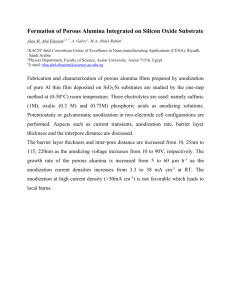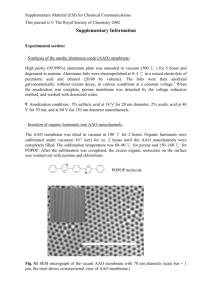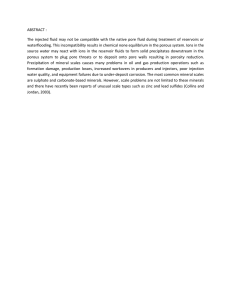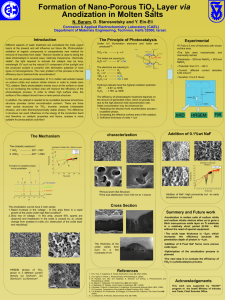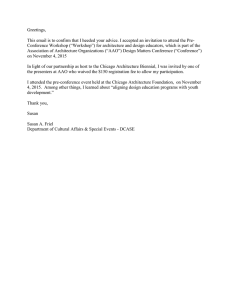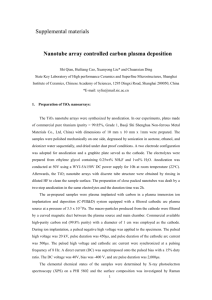Highly ordered porous alumina with tailor-made pore
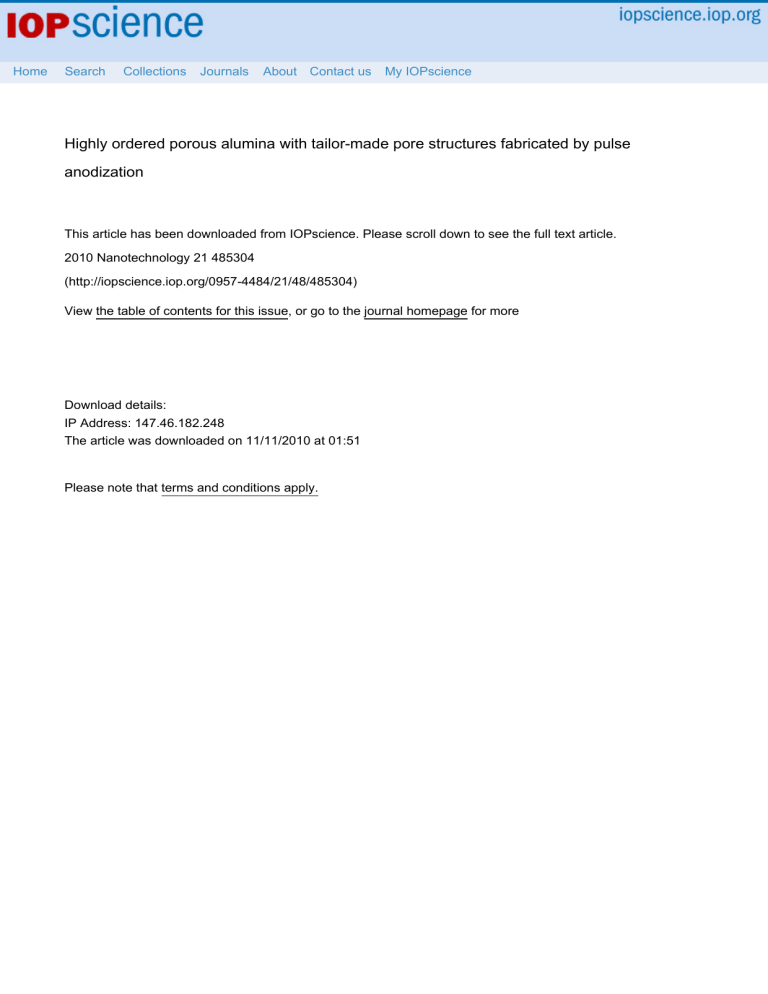
Home Search Collections Journals About Contact us My IOPscience
Highly ordered porous alumina with tailor-made pore structures fabricated by pulse anodization
This article has been downloaded from IOPscience. Please scroll down to see the full text article.
2010 Nanotechnology 21 485304
(http://iopscience.iop.org/0957-4484/21/48/485304)
View the table of contents for this issue, or go to the journal homepage for more
Download details:
IP Address: 147.46.182.248
The article was downloaded on 11/11/2010 at 01:51
Please note that terms and conditions apply.
IOP P
UBLISHING
Nanotechnology 21 (2010) 485304 (8pp)
N
ANOTECHNOLOGY doi:10.1088/0957-4484/21/48/485304
Highly ordered porous alumina with tailor-made pore structures fabricated by pulse anodization
Woo Lee
1
,
2
,
3
and Jae-Cheon Kim
1
1 Korea Research Institute of Standards and Science (KRISS), Yuseong, 305-340 Daejeon,
2
Korea
Department of Nano Science, University of Science and Technology, Yuseong,
305-333 Daejeon, Korea
E-mail: woolee@kriss.re.kr
Received 20 May 2010, in final form 22 October 2010
Published 10 November 2010
Online at stacks.iop.org/Nano/21/485304
Abstract
A new anodization method for the preparation of nanoporous anodic aluminum oxide (AAO) with pattern-addressed pore structure was developed. The approach is based on pulse anodization of aluminum employing a series of potential waves that consist of two or more different pulses with designated periods and amplitudes, and provides unique tailoring capability of the internal pore structure of anodic alumina. Pores of the resulting AAOs exhibit a high degree of directional coherency along the pore axes without branching, and thus are suitable for fabricating novel nanowires or nanotubes, whose diameter modulation patterns are predefined by the internal pore geometry of AAO. It is found from microscopic analysis on pulse anodized AAOs that the effective electric field strength at the pore base is a key controlling parameter, governing not only the size of pores, but also the detailed geometry of the barrier oxide layer.
S Online supplementary data available from stacks.iop.org/Nano/21/485304/mmedia
(Some figures in this article are in colour only in the electronic version)
1. Introduction
Nanoporous anodic aluminum oxide (AAO) formed by anodization of aluminum has increasingly become a popular template system in the development of functional nanostructures.
AAO membranes with tailor-made internal pore structure could provide not only a new degree of freedom in template-
based fabrications of advanced functional materials [ 1–4 ],
but a model system for investigating separations of particles
and adsorption characteristics of molecules [ 5–9 ].
Previously, fabrication of highly ordered AAO membranes with periodically modulated diameter of nanopores was realized by combining conventional mild anodization (MA) with low current density ( j
=
1–5 mA cm
−
2 ) and hard anodization
(HA) with high current density ( j
=
30–250 mA cm
−
2 ), in which each modulation step required the exchange of the
3
Author to whom any correspondence should be addressed.
electrolyte solutions in order to satisfy both MA and HA
processing conditions [ 10 ]. This work led to a development of
a process called ‘pulse anodization’, in which periodic pulses consisting a low potential (or current) pulse followed by a high potential (or current) pulse were applied to achieve MA and
HA conditions, respectively [ 11 , 12 ]. Continuous engineering
of both the internal pore structure and the composition of nanoporous AAO was demonstrated by utilizing the pulse anodization of aluminum for the sulfuric acid electrolyte, avoiding the tedious periodic replacement of the electrolyte solutions.
However, it turned out that the process is not effective in terms of processing time for other electrolyte systems (e.g., oxalic or phosphoric acid) due to the slow recovery of current during MA-pulses especially at a low temperature (e.g., 1
◦
C).
In an extension of the previous
works [ 11 , 12 ], Losic et al reported a cyclic process [ 13 ],
in which an anodizing current in the form of waves was
0957-4484/10/485304+08 $30.00
1 © 2010 IOP Publishing Ltd Printed in the UK & the USA
Nanotechnology 21 (2010) 485304 W Lee and J-C Kim
Figure 1. Schematics showing (a) the experimental process for the fabrication of AAO with tailor-made pore structures by pulse anodization of aluminum and (b) a generalized form of a potential pulse employed in pulse anodizations. U waves, where U j
= the potential at the time t j with U
1
=
U
5
( j
=
1–4),
τ i j
= t j
+
1
− t j j and
τ i j define the repeating unit of potential
, i
= the pulse number (i
=
1
,
2
,
3
, . . .
).
applied in order to combine MA and HA conditions. However, the resulting pores are distorted, losing their directional coherency, although the process demonstrates transformation of the current profiles into structural pore features.
Recently, we showed that AAOs which experienced spontaneous current oscillations (amplitude
∼
0
.
8 A cm
− 2
) during HA conducted under a specific condition can have modulated pore structures, in which the internal pore geometries follow exactly the details of the oscillating current
profile [ 14 ]. The self-induced oscillatory kinetic behaviors
are not controllable per se, and thus the shape, amplitude, and period of the pore modulations are not controllable.
Nevertheless, the experimental results give the important information that one may achieve structural engineering of nanoporous AAO by deliberately manipulating the anodizing current during a potentiostatic anodization of aluminum.
Here, we report a generic anodization method for the fabrication of highly ordered nanoporous AAOs with tailor-made pore structures, in which diameters of oxide nanopores are modulated with designated patterns.
The method is based on pulse anodization of aluminum under potentiostatic conditions. Pores of the resulting AAOs exhibit a high degree of directional coherency along the pore axes without any bifurcations, and thus are suitable for fabricating novel nanowires or nanotubes, whose diameter modulation patterns are predefined by the internal pore geometry of
AAO. We show further that AAO membranes with threedimensional (3D) porous architectures can readily be utilized as templates by demonstrating the fabrication of novel patternaddressed gold nanowires that can be used not only as particle scaffolds for multiplexed bioassays, but also as model systems for investigating topography-induced optical
properties [ 1 , 2 , 4 , 15 ].
2. Experimental section
As-received aluminum discs (2 cm in diameter, Goodfellow,
99.999%) were used in anodization experiments without the annealing step. The aluminum discs were electrochemically polished in a vigorously stirred 1:4 mixture solution of 65%
HClO
4 and 99.5% ethanol (5
◦
C) in order to exclude the effect (e.g., localized field concentration) that could arise from the surface roughness during the anodization. The finished aluminum disc was placed in an electrochemical cell with an
O-ring, so that one side of metal could be anodized. The area exposed to the electrolyte solution was 1
.
96 cm
2
. All anodization experiments in the present work were performed by using an electrochemical cell equipped with a cooling stage that is in thermal contact with the aluminum substrate to remove the reaction heat. The experimental process comprises two consecutive anodizations using 0.3 M oxalic acid as an electrolyte.
The first-step hard anodization (HA) was conducted at 140 V for 20 min according to the method
reported previously [ 10 ], which enables a uniform growth
of AAO during the subsequent pulse anodization (step (i) in figure
1 (a)). Subsequently, the second-step pulse anodization
was carried out at temperatures ranging from 0 to 15
◦
C to address patterns into the oxide nanopores by applying a series of potential waves with different shapes (step (ii) in figure
1 (a)). The current densities ( j ) reported in this paper
were calculated by dividing the measured values of current (I ) by the anodized sample area, not by the effective surface area considering the detailed hemispherical geometry of the barrier layer. For microscopic characterizations of AAOs, aluminum substrate was removed by using a mixture solution of CuCl
2 and HCl.
Free-standing porous AAO membranes with controlled internal pore structures obtained by stepwise voltage reduction
technique were used for electrodeposition of metals [ 16 ]. A
thin layer (20 nm) of silver was sputter deposited on the bottom side of the AAO membrane in a sputter coater (208HR,
Cressington, UK) equipped with a high resolution thickness monitor (MTM-20, Cressington, UK) in order to make the surface electrically conductive.
This silver layer serves as a working electrode in the subsequent electrodeposition of the desired metal.
Firstly, nickel was deposited into
2
Nanotechnology 21 (2010) 485304 the pores from a solution comprised of 8
.
41
×
10
−
2
NiCl
2
·
6H
2
O, 1.59 M Ni
(
H
2
NSO
3
)
2
·
4H
2
O, 0.33 M H
3
BO
M
3
, sodium acetate buffer (pH 3.4).
Secondly, gold was deposited by using a commercially available plating solution
(Auruna 5000).
The current densities for nickel and gold deposition were 3
.
0 mA cm
−
2 and 2
.
5 mA cm
−
2 , respectively.
The total membrane area in contact with the electrolyte was 1
.
0 cm 2 .
After gold electrodeposition, the resulting sample was immersed into a concentrated HNO
3 solution to remove the silver working electrode layer and the nickel segments. Pattern-addressed gold nanowires could be isolated by completely dissolving AAO template using 0.01 M KOH solution at room temperature.
3. Results and discussion
The current in anodization of aluminum under a potentiostatic condition is related to the passage of ions through the barrier oxide layer at the pore bottom. Previous studies indicate that the anodization current is dependent on the thickness and the
chemical composition of the barrier oxide [ 10 , 11 ]. For a given
anodization potential (U ), the current density ( j ) is inversely proportional to the logarithm of the barrier layer thickness (t b
) through the following equation; j
= j
o exp
(β
E
) = j o exp
(β
U
/ t pulse anodization of aluminum in H
2
C
2
O
4 b or H
), where j o
U / t b and
β are the material-dependent constants and is the effective electric field strength (E) across the barrier layer of thickness t b
On the other hand, for a given electrolyte system, the barrier layer thickness
(t b
ζ MA t b
) increases with anodization potential (U ) at a rate of
∼ 1 .
2 nm V
−
1 for MA and ζ HA t b
∼ 0 .
6–1 .
0 nm V
−
1 for
HA [ 10 , 19–23 ]. Therefore, when the anodization potential
is switched from a higher value satisfying the HA condition
(i.e., U
HA
) to a lower MA one (i.e., U
MA
), the current drops abruptly to a very small value and then gradually increases with time to a steady value corresponding to U
MA
(i.e., current
recovery) [ 11 ]. The recovery behavior of the current can be
related to the gradual decrease of the barrier layer thickness
(i.e., the gradual increase of the effective electric field strength,
E) due to the field-induced viscous flow of oxide material from
the center of the pore base toward the cell boundary [ 24 , 25 ]
and/or to the slow dissolution of the oxide layer into the
In pulse anodization of aluminum, current recovery within a reasonable period of time is a prerequisite for the continuous engineering of the internal pore structure of AAO. For a given electrolyte system, the time required for a complete current recovery is dependent on the temperature and the potential difference between U
MA and U
HA
.
For three major pore forming acid electrolytes (i.e., H
2
SO
4
, H
2
C
2
O
4
, and H
3
PO
4
), the current recovery time is governed by the chemical nature of the barrier oxide (i.e., the degree of incorporation of acid anion) and increases in the order H
2
SO
4
<
H
2
C
2
O
4
<
H
3
PO
4
[ 27 ]. Accordingly, unlike the case of H
2
SO
4
-based
pulse anodization [ 11 ], it is difficult to achieve a continuous
3
PO
4 solution
W Lee and J-C Kim due to the very slow recovery of current, especially at a low temperature and a large potential difference.
In the present study, the problem associated with the slow current recovery could be overcome by increasing the potential gradually prior to pulsing a high potential. Figures
show schematically the fabrication procedure of AAOs with tailor-made pore structures and a generalized form of the potential pulses employed, respectively.
The experimental process comprises two consecutive anodizations using 0.3 M oxalic acid as an electrolyte. The first-step hard anodization
(HA) was conducted at 140 V for 20 min according to the
method reported previously [ 10 ], which enables a uniform
growth of AAO during the subsequent pulse anodization
(step (i) in figure
Subsequently, the second-step pulse anodization was carried out to address patterns into the oxide nanopores by applying a series of potential waves with different shapes (step (ii) in figure
potential waves, which determines the modulation pattern of pores, can be constructed by combining pulses with designated periods and amplitudes. Each pulse consists of four segments of potential ramps defined by the potentials (U widths ( t
5
− t
1
τ i j
), where U j
= the potential at the time t
= the period of a pulse,
τ i j
= t j + 1
− t j j
) and the time j
( j
=
1–5),
, and i
= the pulse number (i
=
1
,
2
,
3
, . . .
) (figure
of potential wave (e.g., square, triangle, or sawtooth) can be generated by appropriately varying U j and
τ i j
. The length of oxide nanopores with a smaller diameter can be controlled by varying the time width
τ
i1
(i.e., the first segment in figure
during which the recovery of current takes place.
On the other hand, the length and the internal pore geometry of oxide nanopores with a larger diameter can be tuned by appropriately varying the pulse duration and the amplitude, which are defined by (
τ
i2
,
τ
i3
,
τ
i4
) and (U
2
, U
3
, U
4
), respectively.
Figure
presents the effect of the pulse parameters on the structure of the resulting AAO; ((a), (c))
τ
U
τ
12
13
U
3
4
=
=
2 s,
U
4
τ
13
=
0 s, U
1
=
160 V, ((b), (d))
τ
=
0
.
5 s,
τ
14
=
=
τ
14
0 s, U
1
11
=
40 V, U
2
=
=
80 V, U
2
54 s,
τ
11
τ
12
=
30 s,
=
140 V,
=
1 s,
=
140 V, U
3
=
=
160 V. Current–time transients during pulse anodization of aluminum commonly show that potential pulsing results in the sharp increase of current density and correspondingly the integrated charge (figures
2 (a) and (b)). As a consequence
of the periodic current surges, the resulting AAOs exhibit modulated pore structures without disordering or branching of pores (figures
2 (c) and (d)), in which the length of each
modulation is proportional to the corresponding integrated charge. A typical recovery behavior of the anodizing current can be observed during the potential sweep from U
1 to U
2
. It appears from the insets of figures
current recovery starts at an anodizing potential around 112 V, below which the current recovery is negligible. Therefore, the contribution of the potential below 112 V to the formation of anodic oxide can be ignored under the present electrochemical conditions.
Our control experiments revealed that the rate of potential sweep from U
1 to U
2 does not affect the onset potential of the current recovery, while it affects the current efficiency for the formation of AAO (i.e., the amount of anodic oxide formed per unit charge density); the current efficiency
3
Nanotechnology 21 (2010) 485304 W Lee and J-C Kim
Figure 2. ((a), (b)) Representative current–time (left axes) and charge–time (right axes) transients during pulse anodizations of aluminum using 0.3 M H
2
O
4
◦ =
40 V, U
2
=
U
4
=
54 s,
τ
12
τ
13
=
0
.
5 s,
τ
14
C
2
(5
=
0 s, U
1
C); (a)
τ
11
=
80 V, U
=
30 s,
τ
12
2
=
2 s,
τ
13
=
140 V, U
3
=
U
4
= τ
14
=
0 s, U
1
=
140 V, U
3
=
160 V. (b)
τ
11
=
1 s,
=
160 V. The insets show potential–current plots of the respective anodizations.
((c), (d)) Cross-section SEM micrographs of the resulting respective AAOs with modulated pore structures. The repeating units of the potential wave are shown as insets of the respective SEM images. Scale bars
=
1
μ m.
was observed to decrease with the rate of potential sweep (see supporting information, figure S1 available at stacks.iop.org/
Nano/21/485304/mmedia ).
In general, the pore diameter (D p
) and the cell size
(i.e., the interpore distance D int
) of porous AAO are linearly proportional to the anodization potential for both MA and
But the potential dependence of the former is known to be not as sensitive to the interplay of current density ( j ), temperature, concentration, and the nature of the
electrolyte used [ 29–32 ]. In fact, our recent study showed
clearly that pore diameter (D p
) increases with the current density ( j ) even at a fixed potential, that is, with the effective
electric field strength (E) across the barrier layer [ 14 ]. In order
to see the effect of the potential pulsing on the structure of the resulting AAO, we have performed a comparative investigation on the internal morphologies of oxide nanopores that were prepared from two separate anodization experiments, whose reactions were terminated at U
2 aluminum.
and U
4 during anodization of
Figures
3 (a) and (b) present the barrier layer structures
of AAOs prepared by stopping the anodization reactions at
(a) 140 V ( j
=
0
.
0667 A cm
1
.
2760 A cm
− 2
).
− 2
) and (b) 160 V ( j
=
A schematic cross-section of AAO on aluminum and the parameters defining the geometry of the barrier layer are shown in figure
figure
It was found from the structural analysis of the samples that the potential dependences of both the interpore distance (
ζ
1
.
93 nm V
0
.
91 nm V
1
.
8–2
.
−
1
−
1 than those (
ζ for (b)) and the barrier layer thickness (
ζ for (a) and 0
.
77 nm V
−
1
MA
D int
=
2
.
5 nm V
−
1
0 nm V
−
1 ,
ζ t
HA b
D int
=
2
.
14 nm V
,
ζ t
MA b t b for (b)) are smaller
=
0
.
6–1
.
0 nm V
−
1
=
1
− 1
.
for (a) and
2 nm V
ζ
−
1
=
) of
HA
D int
=
) of hard anodized
ones [ 10 , 21–23 ]. Since the inverse of the potential dependence
4
Nanotechnology 21 (2010) 485304 W Lee and J-C Kim
Figure 3. Cross-section SEM micrographs of AAOs as-prepared from two separate anodization experiments using 0.3 M H
2
C
2
O
4
(15
◦
C), whose reactions were terminated at (a) U
=
140 V ( j
=
0
.
0667 A cm
− 2 ) and (b) U
=
140 V, j
=
1
.
2760 A cm
− 2 . Scale bars
=
300 nm. The inner and outer concentric circles in both SEM images are introduced to depict the e/o and o/m interface profiles, respectively. (c) A schematic cross-section of AAO on aluminum. (d) The parameters defining the geometry of the barrier layer shown in (c): D p
= the pore diameter,
D int
=
2a
= the interpore distance dependence of t b
= the cell size, t b
= the thickness of the barrier layer (
= b
+
c), R
= the radius of curvature (
= a
/ sin
θ
),
θ = the angle from the pore axis to the ridge-top (
= cos
−
1 [
1
−
2b 2 /( a 2 + b 2 ) ]
),
ζ
D int
= the potential dependence of D int
,
ζ t b
= the potential
, E
= the effective electric field strength across the barrier layer. (e) A schematic illustrating the evolution of the barrier layer morphology upon increase of the cell size (2a), D p
, and t b of AAO without changing the pore axes.
of the barrier layer thickness (i.e.,
ζ t
−
1 b
) is equivalent to the effective electric field strength (E) at the pore base, the barrier layer structures shown in figures
to those of AAOs formed at a lower E and a higher E, respectively. Upon close examination of the SEM micrographs, we found that the detailed shapes of the electrolyte/oxide (e/o) and oxide/metal (o/m) interfaces are dependent on the electric field strength (E). AAO formed at a lower E turned out to have an elliptical e/o interface as it deviates from the inner concentric circle (see the white circles in figure
was suggested to be an important shape for controlling the uniformity of the interface speed in the scalloped region of the
barrier layer [ 34 ], while the e/o interface of AAO formed at
a higher E could be more properly depicted by a circular one
(figure
3 (b)). In addition, the curvature radius ( R
= a
/ sin
θ
) of the o/m interface was observed to be larger for AAO formed at a high E compared to that at a low E (i.e.,
θ at high E
).
θ at low E >
The observed evolution of the radius (R) of curvature of the o/m interfaces can be explained by a simple geometric consideration (figure
During pulse anodization, switching of the anodization potential from a low value (i.e., a low E) to a higher one (i.e., a high E) will accompany increase of the cell size (2a), the pore diameter (D p
), and the barrier layer thickness (t b
) of AAO (dashed lines in figure
Since the increase of these structural parameters takes place without changing the pore axes, the o/m interfaces of the individual oxide cells will overlap with those of their six
5
Nanotechnology 21 (2010) 485304 W Lee and J-C Kim
Figure 4. Cross-section SEM micrographs of nanoporous AAOs with modulated pore structures prepared by pulse anodization of aluminum;
(a)
τ
11
=
36 s, (b)
τ
11
=
144 s, (c)
τ
11
Other parameters were fixed at U
1
= τ
21
=
80 V, U
=
36 s,
τ
31
2
= τ
41
=
140 V, U
3
=
=
144 s, and (d)
τ
U
4
=
160 V,
τ
i2
11
= τ
21
= τ
i4
=
144 s,
=
0 s,
τ
i3
τ
31
=
36 s,
τ
41
=
144 s,
τ
51
= τ
61
=
36 s.
=
0
.
2 s, where i denotes the pulse number
(i
=
1
,
2
,
3
, . . .
). The repeating units of pulses are shown as insets in the respective images. Anodization was conducted using 0.3 M H
(1
◦
C). Subsequently, pores were widened by immersing the resulting samples into 0.3 M H
2
C
2
O
4
(15
◦
C) for 16 h.
2
C
2
O
4 nearest neighbors, lowering the ridge height (i.e.,
γ
1
γ
1 at high E at low E > in figure
3 (d)). As a result, the curvature radius of
the o/m interface of AAO at a high E is larger (i.e., R
>
R;
θ < θ in figure
We believe that the detailed geometry of the barrier layer plays an important role, governing the local distributions of the electric field and the current within the barrier oxide, and thus the evolution of mechanical stresses at the barrier layer as well
that the rate of o/m interface motion at the scalloped region and the ridge sensitively varies with the elliptic e/o interface profile, and predicted the pseudoconvective motion of mobile anions from the pore center towards the cell boundary, which accounts for both recession of the e/o interface at the pore base and also accumulation of oxide at the pore wall, unlike previous models based on field-assisted chemical dissolution
of oxide [ 28 , 36 , 37 ]. A complete understanding of the effect
6
Nanotechnology 21 (2010) 485304 W Lee and J-C Kim
Figure 5. SEM micrographs of pattern-addressed gold nanowires prepared by electrodeposition of gold into AAO templates with the pore structures (a) shown in figures
of the interface profiles on the anodization kinetics needs more systematic study.
The present pulse anodization method enables continuous engineering of the pore structure of AAOs. To demonstrate its facile tailoring capability of the internal pore structures, AAOs with a variety of pore modulation patterns were fabricated by employing a series of potential waves that consist of two or more different pulses with the desired periods and amplitudes.
Cross-sectional SEM images of representative examples of AAO are presented in figures
Four different repeating units of potential waves (shown as insets of the respective images) were applied during anodization of aluminum: (a)
36 s,
τ
41
τ
31
=
=
144 s,
τ fixed at U
τ
i2
= τ
i4
1
τ
41
τ
=
11
=
0 s,
τ
=
36 s, (b)
τ
144 s, and (d)
=
τ
11
11
=
= τ
144 s, (c)
21
= τ
21
=
=
36 s,
36 s; the other parameters were
=
140 V, U
3
=
U
τ
4
11
=
144 s,
τ
31
=
51
= τ
i3
61
80 V, U
2
=
160 V,
=
0
.
2 s (i
= the pulse number). As manifested by the present examples, the modulation patterns of the oxide nanopores follow exactly the profile details of the repeating potential units as a result of the periodic surges of current density, i.e., the electric field strength E (see supporting information, figure S2 available at stacks.iop.org/
Nano/21/485304/mmedia ), indicating successful addressing of modulation patterns into the oxide nanopores.
It is expected that fabrication of AAOs with even more complex porous architectures can readily be achieved by appropriately designing the repeating unit of the applied potential.
It is worth mentioning that pores of AAOs fabricated by the present pulse anodization method are well ordered and exhibit a high degree of directional coherency along their axes without disordering (see supporting information, figure S3 available at
4. Conclusions
stacks.iop.org/Nano/21/485304/mmedia predefined by the internal pore structure of AAOs.
The resulting pattern-addressed nanostructures may have potential of utilization not only as particle scaffolds (i.e., nanobarcodes) for multiplexed bioassays, but also as model systems for investigating topography-induced optical, electronic, and
magnetic properties [ 1 , 2 , 4 , 15 , 38 ].
In fact, we were able to fabricate novel shape-addressed gold nanowires by performing electrodeposition of gold into AAO templates by taking advantage of the tailoring capability of the pore structure and also the highly ordered nature of oxide nanopores (see figure
5 ). Apart from template preparation, we expect that our
anodization method will offer a promising fabrication strategy for AAOs with 3D porous architectures that could be used for
photonic applications [ 39 , 40 ].
).
Therefore, AAO membranes with tailor-made pore structures are suitable as templates for preparing novel nanowires or nanotubes, of which the patterns of diameter modulation are
In summary, a new tailoring method of the pore structure of anodic aluminum oxide (AAO) has been developed.
The approach is based on pulse anodization of aluminum employing a series of potential waves that consist of two or more different pulses with deliberately chosen periods and amplitudes.
As a consequence of periodic surges of the anodizing current in compliance with the profile details of the
7
Nanotechnology 21 (2010) 485304 applied potential, the pores of the resulting AAO are modulated along their pore axes.
Microscopic investigation on pulse anodized AAOs reveals that the effective electric field strength
(E) at the pore base has profound implications on the structure of AAO, governing the detailed geometry of the barrier oxide layer as well as the size of pores.
Acknowledgment
This work is supported by Korea Research Council of
Fundamental Science and Technology (KRCF) through the
KRISS project of ‘Development of Advanced Industrial
Metrology’.
References
[1] Finkel N H, Lou X, Wang C and He L 2004 Anal. Chem.
76 353A
[2] Brunker S E, Cederquist K B and Keating C D 2007
Nanomedicine 2 695
[3] Matthias S, Schilling J, Nielsch K, M¨uller F, Wehrspohn R B and G¨osele U 2002 Adv. Mater. 14 1618
[4] He B, Son S J and Lee S B 2006 Langmuir 22 8263
[5] Matthias S and M¨uller F 2003 Nature 424 53
[6] Casanova F, Chiang C E, Li C-P and Schuller I K 2007 Appl.
Phys. Lett.
91 243103
[7] Bruschi L, Fois G, Mistura G, Sklarek K, Hillebrand R,
Steinhart M and G¨osele U 2008 Langmuir 24 10936
[8] Casanova F, Chiang C E, Li C-P, Roshchin I V, Ruminski A M,
Sailor M J and Schuller I K 2008 Nanotechnology
19 315709
[9] Bruschi L, Mistura G, Liu L, Lee W, G¨osele U and
Coasne B 2010 Langmuir 26 11894
[10] Lee W, Ji R, G¨osele U and Nielsch K 2006 Nat. Mater. 5 741
[11] Lee W, Schwirn K, Steinhart M, Pippel E, Scholz R and
G¨osele U 2008 Nat. Nanotechnol. 3 234
[12] Lee W, Scholz R and G¨osele U 2008 Nano Lett. 8 2155
[13] Losic D, Lillo M and Losic D Jr 2009 Small 5 1392
[14] Lee W, Kim J-C and G¨osele U 2010 Adv. Funct. Mater. 20 21
W Lee and J-C Kim
[15] Vesseur E J R, de Waele R, Kuttge M and Polman A 2007 Nano
Lett.
7 2843
[16] Lee W, Scholz R, Nielsch K and G¨osele U 2005 Angew. Chem.
Int. Edn 44 6050
[17] G¨untherschulze A and Betz H 1934 Z. Phys. 92 367
[18] Lohrengel M M 1993 Mater. Sci. Eng. R 11 243
[19] Keller F, Hunter M S and Robinson D L 1953 J. Electrochem.
Soc.
100 411
[20] Hunter M S and Fowle P 1954 J. Electrochem. Soc. 101 481
[21] Schwirn K, Lee W, Hillebrand R, Steinhart M, Nielsch K and
G¨osele U 2008 ACS Nano 2 302
[22] Lee W, Nielsch K and G¨osele U 2007 Nanotechnology
18 475713
[23] Lee W 2010 JOM 62 57
[24] Garcia-Vergara S J, Skeldon P, Thompson G E and
Habazaki H 2006 Electrochim. Acta 52 681
[25] Skeldon P, Thompson G E, Garcia-Vergara S J,
Iglesias-Bubianes L and Blanco-Pinzon C E 2006
Electrochem. Solid-State Lett.
9 B47
[26] Nagayama M, Tamura K and Takahash H 1970 Corros. Sci.
10 617
[27] Thompson G E and Wood G C 1981 Nature 290 230
[28] O’Sullivan J P and Wood G C 1970 Proc. R. Soc. A 317 511
[29] Parkhutik V P and Shershulsky V I 1992 J. Phys. D: Appl.
Phys.
25 1258
[30] Paolini G, Masoero M, Sacchi F and Paganelli M 1965
J. Electrochem. Soc.
112 32
[31] Ebihara K, Takahashi H and Nagayama M 1983 J. Met. Finish.
Soc. Japan 34 548
[32] Sulka G D and Parkoła K G 2007 Electrochim. Acta 52 1880
[33] Nielsch K, Choi J, Schwirn K, Wehrspohn R B and
G¨osele U 2002 Nano Lett. 2 677
[34] Houser J E and Hebert K R 2006 J. Electrochem. Soc.
153 B566
[35] Houser J E and Hebert K R 2009 Nat. Mater. 8 415
[36] Li F, Zhang L and Metzger R M 1998 Chem. Mater. 10 2470
[37] Su Z and Zhou W 2008 Adv. Mater. 20 3663
[38] Allende S, Altbir D and Nielsch K 2009 Phys. Rev. B
80 174402
[39] Masuda H, Yamada M, Matsumoto F, Yokoyama S, Mashiko S,
Nakao M and Nishio K 2006 Adv. Mater. 18 213
[40] Masuda H, Ohya M, Asoh K, Nakao M, Nohtomi M and
Tamamura T 1999 Japan. J. Appl. Phys. 38 L1403
8
